Goscombe John
Sir William Goscombe John RA (21 February 1860 – 15 December 1952[1]) was a prolific Welsh sculptor known for his many public memorials. As a sculptor, John developed a distinctive style of his own while respecting classical traditions and forms of sculpture. He gained national attention with statues of eminent Victorians in London and Cardiff and subsequently, after both the Second Boer War and World War I, created a large number of war memorials. These included the two large group works, The Response 1914 in Newcastle upon Tyne and the Port Sunlight War Memorial which are considered the finest sculptural ensembles on any British monument.[2][3]
Sir Goscombe John | |
|---|---|
 Portrait by Simon Hermon Vedder, 1901 | |
| Born | 21 February 1860 Cardiff, Wales |
| Died | 15 December 1952 (aged 92) London, England |
| Education | |
| Known for | Sculpture |
| Movement | New Sculpture |
| Spouse |
Martha Weiss
(m. 1891; died 1923) |
| Awards | Knight Bachelor (1911) |
Although as a young man he adopted the first name Goscombe, taken from the name of a village in Gloucestershire near his mother's home, he was actively engaged with his native Wales and Welsh culture throughout his career.[3][4]
Biography
Early life and career
John was born in the Canton area of Cardiff, to Thomas John, a wood carver from Llantrithyd and Elizabeth (née Smith), from Randwick, Gloucestershire.[5][1] As a youth John assisted his father in the restoration of Cardiff Castle and Castell Coch during 1874 which was being overseen by William Burges.[1][6] He initially studied in his home town, attending the Cardiff School of Art throughout the 1870s and also took anatomy classes from a local painter.[1]
John moved to London in 1881 and worked as a pupil-assistant in the studio of Thomas Nicholls, Burges' architectural carver.[6][7] John then studied at the South London School of Technical Art under Jules Dalou and William Silver Frith and then at the Royal Academy Schools, where he won the gold medal and a travelling scholarship in 1887.[8][6] Throughout 1890 and 1891 he travelled in Europe and Africa and, in 1891, took a studio in Paris where he studied with Auguste Rodin.[1][8] John's statuette, Morpheus clearly reflected the influence of Rodin on his development and the piece received an honourable mention when shown at the Paris Salon in 1892.[9][3][10] Following the success of Morpheus, John created a series of exhibition pieces that embraced the naturalistic style of the New Sculpture movement and cemented his reputation.[10] John the Baptist, 1894, a life-sized figure cast in block tin for Lord Bute won a gold medal at the 1900 Paris Exhibition.[3][1]
Other notable works from this period included Girl Binding her Hair, 1893, The Elf, 1898 and A Boy at Play, 1895.[10] A Boy at Play was subsequently purchased by the Chantrey Bequest for the Tate.[11] The Elf was highly praised when shown at the Royal Academy in 1898 and was subsequently reproduced both in bronze and marble to become among John's most popular works.[9] John received gold medals from the Paris Salon in 1892 and, for his statue of the Duke of Devonshire, in 1901.[3]
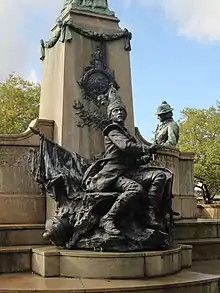
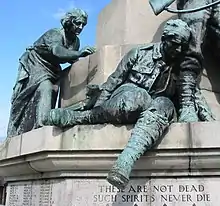
.JPG.webp)
Major works
By the early 1900s John had established himself as a sculptor of some note and began to receive significant public commissions.[10][7] Although based in London, John won a number of large commissions in his native Wales. He designed the Hirlas Horn for the 1898 National Eisteddfod of Wales and a set of ceremonial tools to mark the building of the National Museum Wales in Cardiff.[1] For the monument, unveiled in 1899 and known as The Girl, to Welsh poets and preachers at Llansannan, John depicted a girl in modern clothing wrapped in a traditional Welsh cloak.[4] The creation of that monument had been promoted by the Welsh nationalist Thomas Edward Ellis and when he died, also in 1899, John was selected to sculpt his memorial statue which was unveiled at Bala in 1903 by David Lloyd George.[4] John's statue of the shipping magnate and philanthropist John Cory was erected in Cathays Park in the centre of Cardiff and is one of several statues by him in, or near, the park. These include the 1906 bronze statue of Lord Tredegar which was John's first equestrian statue.[9] His 1916 marble St David Blessing the People is also nearby in the Marble Hall of Cardiff City Hall.[10][12]
John received a further number of national and international commissions, including several for war memorials. John's 1905 King's Regiment Boer War memorial in St John's Gardens, Liverpool depicts two soldiers of the regiment from different historical periods, one from the 17th century and one from the Boer War period, around a figure of Britannia on a pedestal.[2] John created a similar representation of a regiment's heroic traditions for the 1924 Royal Welch Fusiliers memorial at Wrexham which features statues of 18th and 20th century soldiers.[2] On the reverse of the Liverpool monument is a sculpture featuring a regimental drummer boy of 1743. This was subsequently cast as a separate, small bronze in an edition for the retail market and became a popular purchase while a monumental version was also cast and is held by the National Museum Wales.[13]
Before the outbreak of the First World War, John had been commissioned to create a memorial to the 244 engineers who had died with the sinking of the RMS Titanic in 1912.[4] When the monument was completed in 1916, and erected in Liverpool, it was dedicated to all engineers and engine room workers lost at sea, including those killed during the war.[4]
John was commissioned by Lord Leverhulme to design a memorial at Port Sunlight to the 500 plus employees of Lever Brothers Ltd who had died in the First World War.[2] John exhibited a variety of sketches and maquettes for the memorial at the Royal Academy in 1919 and 1920 but left the final selection of figures to Leverhulme.[14] The monument consists of a cross on an octagonal base on an elevated podium. There are large bronze sculptural groups with a total of 11 figures and 12 relief panels on the podium. The main sculpture group shows three soldiers, one shielding a child and one lying wounded with a figure of a nurse approaching him.[14] The sculptural group on the rear of the podium consists of a mother figure with infants and other children. The relief panels on the podium sides show pairs of children carrying wreaths plus panels showing combat scenes including machine gunners in a trench and action stations on the bridge of a warship.[2] The monument was greatly praised for its depiction of military and civilian roles, Nicholas Pevsner described the monument as "genuinely moving and avoids sentimentality".[14]
The Port Sunlight memorial was unveiled in 1921, two years before John's Northumberland Fusiliers Memorial was erected in Newcastle upon Tyne. Known as "The Response 1914" the monument was commissioned to mark the raising of four battalions of volunteers by the local Chamber of Commerce at the start of World War I.[15] In bronze, John created a procession of deep-relief figures representing the volunteers and those they were leaving behind. The procession is led a winged angel, an allegory of renown, blowing a horn above two drummer boys followed by uniformed soldiers and men in civilian clothes, some of whom are saying goodbye to women and children.[15] Although created several years after the end of the war, the monument illustrates the mood of patriotic confidence and resolve that had marked a period at the start of the conflict ten years earlier and makes the work deeply poignant.[2] Writing in 1991, Alan Borg, a former director of the Imperial War Museum described the Port Sunlight and Newcastle memorials as the finest sculptural ensembles on any British monument.[2]
Personal life
John was made a Royal Academician in 1909 and became a corresponding member of the Institut de France.[8][11] He first exhibited at the Royal Academy in London in 1886 and continued to do so annually until 1948.[1] In 1942 he was awarded the gold medal of the Royal Society of Sculptors.[11] He was knighted at Caernarfon Castle in 1911 during the investiture of Edward VIII as the Prince of Wales for which he designed elements of the regalia and a medal.[4] John was influential in the development of the National Museum of Wales, having served on its governing council for over forty years and donated numerous art works to the Museum.[10]
In August 1890, John married the Swiss-born Marthe Weiss.[1] Their daughter Muriel married Luke Val Fildes in 1915, the son of the artist Sir Luke Fildes.[16] From 1892 John lived at Greville Road, Kilburn, London (in a house that had previously belonged to Seymour Lucas), and is buried in Hampstead Cemetery.[17] The memorial statue of his wife, which he designed when she died in 1923, was stolen from the cemetery in 2001 and recovered after a few months; it was then put into storage, but was stolen again in 2007.[18]
Public monuments and memorials
1890–1899
| Image | Title / subject | Location and coordinates |
Date | Type | Material | Dimensions | Designation | Wikidata | Notes |
|---|---|---|---|---|---|---|---|---|---|
_at_Llanboidy_NLW3361627.jpg.webp) |
Memorial to W.R.H Powell | Llanboidy, Carmarthenshire | 1891 | Statue | White marble | Grade II* | Q17742263 | [19] | |
_A_Boy_at_Play_(c1895)_front_right_(background_includes_part_of_Henry_Scott_Tuke_(1858-1929)_August_Blue_(1893-4))%252C_Tate_Britain%252C_Dec_2012_(8298889528).png.webp) More images |
A Boy at Play | Tate Britain, London | c. 1895 | Statue on base | Bronze & stone | [20] | |||
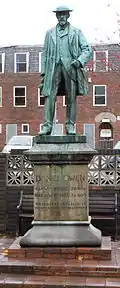 More images |
Daniel Owen | Mold, Flintshire | c.1896, repositioned 1976 | Statue on pedestal | Bronze & stone | Grade II | Q29480968 | [21][22][12] | |
 More images |
The Elf | Kibble Palace, Botanic Gardens, Glasgow | 1899 | Statue on plinth | Marble | 2.25m high | Q84322910 | One of several versions in different materials[23][9] | |
.jpg.webp) More images |
The Girl Tudur Aled |
Llansannan, Conwy | 1899 | Statue on obelisk & plinth | Bronze & stone | Grade II | Q29499309 | Monument to Welsh poets and preachers.[12][24][25] | |
.jpg.webp) More images |
Joyance | Thompson's Park, Cardiff | 1899 | Statue | Bronze | Q47494806 | Also at St Fagans National Museum of History |
1900–1909
| Image | Title / subject | Location and coordinates |
Date | Type | Material | Dimensions | Designation | Wikidata | Notes |
|---|---|---|---|---|---|---|---|---|---|
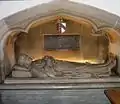 |
Tomb of Dean Charles Vaughan | North choir-aisle of Llandaff Cathedral | 1900 | Tomb with sculpture | Marble | [28] | |||
.jpg.webp) More images |
William Cavendish, 7th Duke of Devonshire | Devonshire Place, Eastbourne | 1901 | Statue on plinth | Bronze & stone | Grade II | Q26295681 | [12][29][6] | |
.jpg.webp) More images |
Memorial to Arthur Sullivan | Victoria Embankment Gardens, London | 1902 | Bust and figure on pedestal | Bronze & granite | Grade II | Q27081637 | [12][30] | |
 More images |
Memorial to Arthur Sullivan | St Paul's Cathedral, London | 1902 | Relief plaque | Bronze | [31] | |||
 More images |
Alfred Thomas, 1st Baron Pontypridd | National Museum Cardiff | 1902 | Bust | Marble | [32] | |||
| Wigan and District Boer War memorial | Mesnes Park, Wigan | 1903 | Sculpture on plinth | Stone with bronze additions | Removed after repeated vandalism.[33] | ||||
.jpg.webp) |
James Reid (1823–1894) | Springburn Park, Glasgow | 1903 | Statue on pedestal | Bronze & granite | Category B | Q17811051 | [34] | |
 More images |
Prince Christian Victor of Schleswig-Holstein | Thames Street, Windsor, Berkshire | 1903 | Statue and surround | Bronze & Portland stone | Grade II | Q26411185 | [35] | |
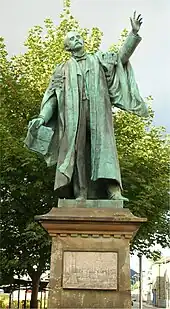 More images |
Thomas Edward Ellis | Bala, Gwynedd | 1903 | Statue on plinth with panels | Bronze & sandstone | c. 4.5m high | Grade II | Q29502898 | A full-size copy is at the Old College, Aberystwyth[12][36] |
 |
Coldstream Guards Boer War memorial | Vestibule of south nave, St Paul's Cathedral, London | 1904 | Plaque in deep relief | Gilt bronze & stone | 1.5m x 0.9m | [37] | ||
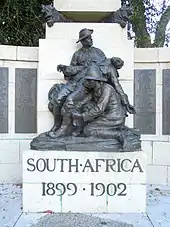 More images |
RAMC Boer War Memorial | Gun Hill, Aldershot | 1905 | Sculpture group, obelisk and wall with plaques | Bronze & granite | Grade II | Q26672950 | Architect, Robert Weir Schultz[38][39] | |
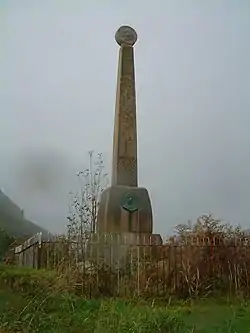 More images |
Memorial to Alfred W. Hughes | Corris, Gwynedd | 1905 | Celtic cross on pedestal with a bronze plaque | Granite | Grade II | Q2949920 | [12][40][41] | |
 More images |
The King's Regiment memorial | St John's Gardens, Liverpool | 1905 | 4 statues with base, pedestal & wall | Bronze & stone | Grade II | Q26333154 | AB Burton (foundry); William Kirkpatrick Ltd (builders)[2][12][42][43][6] | |
| Journalists of the South African War memorial | Crypt of St. Faith, St Paul's Cathedral, London | 1905 | Relief plaque with surround | Bronze and red limestone | [44][45] | ||||
 More images |
Edward VII | Grand Parade, Cape Town, South Africa | 1905 | Statue on pedestal and steps | Marble & granite | 9m tall | Q19623378 | [46] | |
 More images |
Bokani | National Museum Cardiff | 1905 | Bust | Bronze | 35cm | [47] | ||
 More images |
John Cory | Gorsedd Gardens, Cathays Park, Cardiff | 1906 | Statue on pedestal | Bronze & stone | Grade II | Q29491668 | [12][48][49] | |
 More images |
John Cory | National Museum Cardiff | 1906 | Bust | Marble | 70.0cm | [50] | ||
.jpg.webp) More images |
Judge Gwilym Williams of Miskin (1839–1906) | Opposite Crown Court, Cathays Park, Cardiff | 1906 | Statue on plinth | Bronze & stone | Grade II | Q29491700 | [51][52] | |
_(May_2010).JPG.webp) More images |
Memorial to 2nd Battn Royal Sussex Regiment, 1882 to 1902 | Grand Parade, Eastbourne | 1906 | Statue on pedestal | Bronze & stone | Grade II* | Q17555428 | AB Burton (foundry)[12][53][54] | |
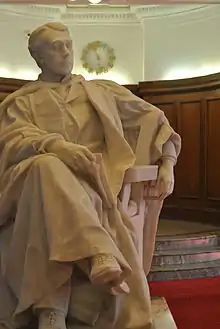 |
John Viriamu Jones | Entrance hall, Main Building of Cardiff University, Cathays Park | 1906 | Statue on pedestal | Marble | [55] | |||
 More images |
William Edward Hartpole Lecky | Trinity College, Dublin | 1906 | Statue on pedestal | Bronze & stone | Q82094233 | |||
 More images |
Bishop Richard Lewis | Llandaff Cathedral, Cardiff | 1908 | Wall-mounted statue with plaque | Bronze | [56] | |||
 More images |
Godfrey Morgan, 1st Viscount Tredegar | Gorsedd Gardens, Cathays Park, Cardiff | 1909 | Equestrian statue on pedestal with reliefs | Bronze & stone | Grade II | Q29491649 | [12][9][57] | |
 More images |
Robert Gascoyne-Cecil, 3rd Marquess of Salisbury | Westminster Abbey, London | 1909 | Altar & effigy | Black marble & bronze | [58] |
1910–1919
| Image | Title / subject | Location and coordinates |
Date | Type | Material | Dimensions | Designation | Wikidata | Notes |
|---|---|---|---|---|---|---|---|---|---|
.jpg.webp) |
Sir James Fergusson, 6th Baronet | Wellington Square, Ayr | 1910 | Statue on pedestal | Bronze & stone | Category B | Q17838501 | [59][60] | |
 More images |
Edward James Saunderson | Portadown, County Armagh | 1910 | Statue on pedestal | Bronze & stone | [61] | |||
 |
The Boy Scout | National Museum Cardiff | 1910 | Statuette | Bronze | Portrait of Basil Webb, son of Henry Webb, and who served as a 2nd lieutenant with the Welsh Guards during the First World War and was killed in December 1917.[62] | |||
.jpg.webp) |
Lewis Edwards memorial | Pen-llwyn, Ceredigion | 1911 | Bust on pedestal | Bronze & granite | Grade II | Q29501128 | [63] | |
.jpg.webp) More images |
Statue of Charles Rolls | Agincourt Square, Monmouth | 1911 | Statue on pedestal | Bronze & granite | Grade II* | Q7604480 | [12][64] | |
 |
Thomas Sutton | Charterhouse School, Surrey | 1911 | Statue on plinth with plaques | Bronze & stone | Grade II | Q26296559 | [65] | |
 More images |
An Indian Procession known as The Minto Panels | Victoria Memorial, Kolkata | 1913 | Four deep-relief panels | Bronze | Previously on the pedestal to John's statue of Gilbert Elliot-Murray-Kynynmound, 4th Earl of Minto, the panels are now located on and near to the base of the statue of Queen Victoria by George Frampton[66][67] | |||
 More images |
Memorial to the Engine Room Heroes of the Titanic | Pier Head, Liverpool | 1916 | Obelisk with statues | Bronze & stone | Grade II* | Q3305518 | [2][68][69] | |
.jpg.webp) More images |
Edward VII | Pier Head, Liverpool | 1916 | Equestrian statue on pedestal | Bronze | Grade II | Q26320984 | [70][8] | |
 More images |
Saint David Blessing the People | The Marble Hall, Cardiff City Hall | 1916 | Statue on pedestal | Marble | [9][71] | |||
| Lieutenant Colonel A. Carteret-Thynne DSO | Parish Church of St. James the Great, Kilkhampton, Cornwall | 1917 | Tablet with figure & plaque | Marble & bronze | Carteret-Thynne was killed in action in 1917, having also served in the South African War.[72] | ||||
 More images |
Statue of Viscount Wolseley | Horse Guards Parade, London | 1917 | Equestrian statue on pedestal | Bronze & Portland stone | Grade II | Q18159880 | [8][12][73][6][11][74] | |
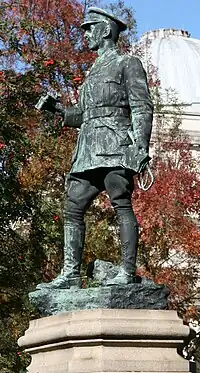 More images |
Lord Ninian Crichton-Stuart | Cathays Park, Cardiff | 1917 | Statue on plinth | Bronze & stone | Grade II | Q29491669 | [75] | |
| Capt H B Knott and Major J L Knott DSO | St Andrew's Church, Heddon-on-the-Wall, Northumberland | 1918 | Tablet with relief figures | Marble | 1.2m by 1.5m | [76] |
1920–1929
| Image | Title / subject | Location and coordinates |
Date | Type | Material | Dimensions | Designation | Wikidata | Notes |
|---|---|---|---|---|---|---|---|---|---|
 |
Caradog, Griffith Rhys Jones | Victoria Square, Aberdare | 1920 | Statue on pedestal | Bronze & stone | Grade II | Q29489462 | [12][77] | |
 More images |
Evelyn Baring, 1st Earl of Cromer | Westminster Abbey, London | 1920 | Plaque with medallion portrait | Marble | [78] | |||
.jpg.webp) More images |
War memorial | Bryn Square, Lampeter | 1921 | Statue on pedestal and raised terrace | Bronze & granite | 4.5m high | Grade II | Q29489055 | Terrace & wall designed by Llewllyn Bankes-Price[2][79][80] |
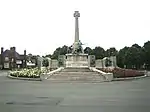 More images |
Port Sunlight War Memorial | Port Sunlight, Merseyside | 1921 | Celtic Cross on an octagonal podium with eleven sculptured figures and twelve relief panels. | Bronze & granite | 11.5m high | Grade I | Q15979246 | AB Burton (foundry); William Kirkpatrick Ltd (builders)[2][14][81][82][83] |
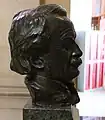 More images |
David Lloyd George | National Museum Cardiff | 1921 | Bust | Bronze, marble base | 35.5cm | [84] | ||
 More images |
David Lloyd George | Castle Square, Caernarfon | 1921 | Statue on plinth | Bronze & stone | Grade II | Q29483625 | AB Burton (foundry); Base by J Fletcher of Caernarfon.[12][85] | |
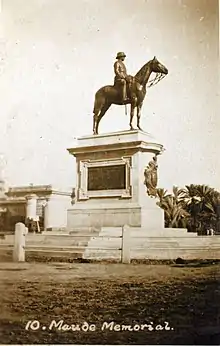 |
Sir Stanley Maude | Baghdad, Iraq | 1921 | Equestrian statue | Bronze | Pedestal by Edward Prioleau Warren, destroyed c. 1958[3] | |||
 |
Statue of Sir John Tomlinson Brunner | Grounds of Brunner-Mond works, Winnington, Cheshire | 1922 | Statue on pedestal | Bronze & granite | Grade II | Q15979536 | [12][86][87] | |
 More images |
Thomas Charles Edwards | Old College, Aberystwyth | 1922 | Statue on pedestal | Bronze & granite | Grade II | Q29488944 | AB Burton (foundry)[12][88][89] | |
 More images |
War memorial | Town Hall Gardens, Llanelli | 1923 | Relief panel and cenotaph | Bronze & granite | Grade II | Q29490305 | [90][91] | |
 More images |
Northumberland Fusiliers Memorial "The Response 1914" | Barras Bridge, Newcastle upon Tyne | 1923 | Bronze relief figures on a granite base with three granite figures on the reverse | Bronze & granite | Grade I | Q17552582 | AB Burton (foundry); William Kirkpatrick Ltd (builders)[2][92][15][83] | |
 |
War memorial | Alexandra Gardens, Penarth | 1924 | Obelisk-mounted sculpture on stepped plinth | Bronze & granite | Grade II | Q29491428 | [93][94] | |
.JPG.webp) More images |
Royal Welch Fusiliers memorial | Junction of Bodhfryd Rd. & Chester Rd., Wrexham | 1924 | Twin sculptures on pedestal | Bronze & stone | Grade II | Q29481992 | [2][95][96] | |
 |
Carmarthen County war memorial | Priory Street, Carmarthen | 1924 | Statue on pedestal and plinth | Bronze & Portland stone | 4.5m high | Grade II | Q29504987 | [97][98] |
 More images |
Llandaff Cathedral School war memorial | Cathedral Green, Llandaff, Cardiff | 1924 | 3 Sculptures on pedestals | Bronze & stone | Grade II | Q29491677 | [2][4][83][99][100] | |
 More images |
Tomb of Lord and Lady Leverhulme | Christ Church, Port Sunlight | c. 1925 | Pair of chest tombs with effigies | Bronze and black marble | Grade II* | [101] | ||
 More images |
James Rice Buckley | Cathedral Green, Llandaff | 1927 | Statue on pedestal | Bronze & granite | Grade II | Q29491672 | [12][102] | |
| Basil Webb | Crypt of Lady Chapel, Hereford Cathedral | Reredos with figures of 3 saints | Basil Webb was the son of Henry Webb who funded the memorial.[103] |
1930 and later
| Image | Title / subject | Location and coordinates |
Date | Type | Material | Dimensions | Designation | Wikidata | Notes |
|---|---|---|---|---|---|---|---|---|---|
 More images |
Evan James & James James | Ynysangharad Park, Pontypridd | 1930 | Two statues on plinths | Bronze | Grade II* | Q17743403 | [12][104][105][106] | |
 More images |
Seymour Berry, 1st Baron Buckland | Outside Central Library, Merthyr Tydfil | 1931 | Statue on pedestal | Bronze & stone | Grade II | Q29489898 | [12][107] | |
 More images |
Bishop Edward Bevan | Brecon Cathedral, Powys | 1935 | Effigy on base | Bronze and stone | Grade 1 | [108] | ||
 More images |
George V | Entrance to Queensway Tunnel, Liverpool | 1939 | Statue | Bronze | ||||
 More images |
Queen Mary | Entrance to Queensway Tunnel, Liverpool | 1939 | Statue | Bronze | ||||
.JPG.webp) More images |
Bishop Joshua Pritchard Hughes | Llandaff Cathedral, Cardiff | 1940 | Plaque | Bronze | [109] |
Other works
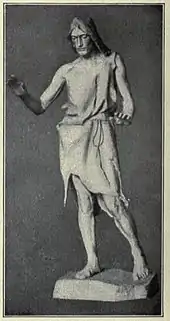
John exhibited medals on at least seven occasions at the Royal Academy between 1898 and 1918.[16] He designed the medal for the 1911 investiture of Edward VIII as Prince of Wales and the King George V Silver Jubilee Medal in 1935.[8][110] During his career John also produced medals and seals for several organisations in Wales. These included medal designs for the Cardiff School of Art and the Welsh Nursing Association plus seals for the National Museum Wales, the Merthyr Tydfil Corporation and the Church of Wales.[111] For the National Eisteddfod Association he designed a medal with bardic images.[4][111]
John's output was prolific and also includes monuments to Lord Salisbury in Westminster Abbey and at St Etheldreda's Church, Hatfield.[3][8] John's output also included:
- Sculptures on Electra House in Moorgate, City of London, dating from 1900 to 1903 and representing Egypt, Japan, India and China.[112][6]
- The work Grief dating to 1890.[113]
- Figures of Edward VII and Queen Alexandra on the facade of the Victoria and Albert Museum, 1906.[114][6]
- Carved figures on a reredos in St John the Baptist Church, Cardiff.[115]
- Designed the regalia for the investiture of the Prince of Wales at Caernarfon in 1911.[8][1]
- Merlin and Arthur (c. 1896), a bronze in the collection of the National Museum Wales which was exhibited at the Royal Academy in 1902.[116]
- Memorial relief to Canon Guy D.D, (1897) in Llandaff Cathedral.[117]
- Bust of the artist John Macallan Swan.[118]
- Bust of Frederick Stanley, Earl of Derby in Preston Town Hall.[119]
- Bust of Lewis Morris, exhibited in 1899 at the Royal Academy.[120]
- Marble statue of Sir John Woodburn, erected Uttar Pradesh 1906, placed in storage at the Uttar Pradesh State Museum during 1958–59[66]
- Marble statue of Sir Digbijai Singh, erected Lucknow 1907, moved to State Museum Lucknow during 1981–82[66]
- Bronze equestrian statue of Gilbert Elliot-Murray-Kynynmound, 4th Earl of Minto, Viceroy of India, erected 1914 at Kolkata and subsequently moved to Barrackpore[66]
- 1915 memorial relief panel in copper and bronze to Sir Patrick Playfair, 1852–1915, St. Paul's Cathedral, Kolkata[66]
- Busts of William Cadwallader and Sir Isambard Owen in the Main Building of Bangor University[121]
References
- Dr. Paul Joyner (2001). "John, Sir William Goscombe (1860–1952), sculptor and medallist". Dictionary of Welsh Biography. Retrieved 20 September 2020.
- Alan Borg (1991). War memorials: From Antiquity to the Present. Leo Cooper. ISBN 085052363X.
- Pearson, Fiona (2014). "John, Sir William Goscombe (1860–1952), sculptor and medallist". In Pearson, Fiona (ed.). Oxford Dictionary of National Biography (online ed.). Oxford University Press. doi:10.1093/ref:odnb/34197. ISBN 978-0-19-861412-8. Retrieved 20 September 2021. (Subscription or UK public library membership required.)
- Peter Lord (2006). The Tradition: A New History of Welsh Art 1400–1990. Parthian. ISBN 978-1-910409-62-6.
- Introduction to "Sir William Goscombe John, R.A., LL.D. Sculpture in the National Museum of Wales Catalogue" dated 1948.
- Susan Beattie (1983). The New Sculpture. Paul Mellon Centre for Studies in British Art / Yale University Press. ISBN 0300033591.
- Oliver Fairclough (1985). A Companion Guide to the Welsh National Museum of Art. Amgueddfa Cymru – National Museum of Wales. ISBN 9780720006131.
- David Buckman (2006). Artists in Britain Since 1945 Vol 1, A to L. Art Dictionaries Ltd. ISBN 0-953260-95-X.
- Eric Rowan (1985). Art in Wales: An Illustrated History 1850–1980. Welsh Arts Council, University of Wales Press. ISBN 0708308546.
- Oliver Fairclough (10 December 2011). "William Goscombe John (1860–1952)". Amgueddfa Cymru – National Museum Wales. Retrieved 11 April 2020.
- Alan Windsor (2003). British Sculptors of the Twentieth Century. Ashgate. ISBN 1-85928-4566.
- Jo Darke (1991). The Monument Guide to England and Wales. Macdonald Illustrated. ISBN 0-356-17609-6.
- "Art Collections Online: The Drummer Boy". National Museum Wales. Retrieved 23 September 2021.
- Historic England. "Port Sunlight War Memorial (1343491)". National Heritage List for England. Retrieved 22 September 2021.
- Historic England. "War Memorial (The Response) (1186201)". National Heritage List for England. Retrieved 22 September 2021.
- University of Glasgow History of Art / HATII (2011). "Sir William Goscombe John RA". Mapping the Practice and Profession of Sculpture in Britain & Ireland 1851–1951. Retrieved 5 April 2020.
- Historic England. "Tomb of Marthe Goscombe John and Sir William Goscombe John in Hampstead Cemetery (1322159)". National Heritage List for England. Retrieved 15 July 2020.
- Carrier, Dan (13 April 2020). "Hampstead Cemetery's Plinth of Thieves". Camden New Journal. Retrieved 18 September 2021.
- Cadw. "WRH Powell memorial in churchyard and iron railings (25616)". National Historic Assets of Wales. Retrieved 18 September 2020.
- "Gallery label: A Boy at Play (c. 1895)". Tate. Retrieved 8 January 2021.
- Cadw. "Statue of Daniel Owen (365)". National Historic Assets of Wales. Retrieved 26 April 2020.
- "Daniel Owen". Hither & Dither. Retrieved 20 November 2012.
- "The Elf by Sir William Goscombe John". www.victorianweb.org. Retrieved 14 January 2020.
- "Writers' memorial, Llansannan". historypoints.org. Retrieved 18 September 2020.
- Cadw. "'The Girl' Memorial Statue (22062)". National Historic Assets of Wales. Retrieved 18 September 2020.
- Cadw. "Thompson's Park (Sir David's Field) (PGW(Gm)71(CDF))". National Historic Assets of Wales. Retrieved 19 March 2023.
- "St Fagans Castle, Joyance Statue, St Fagans". Coflein. Retrieved 19 March 2023.
- "Tomb of Dean Vaughan". Victorian Web. Retrieved 19 November 2012.
- Historic England. "Seated statue of William, 7th Duke of Devonshire, KG, PC, DCL, FRS (1808/1891) (1043674)". National Heritage List for England. Retrieved 18 September 2020.
- Historic England. "Sir Arthur Sullivan Memorial (1238072)". National Heritage List for England. Retrieved 6 April 2020.
- "Memorial to Arthur Sullivan". The Courtauld Institute of Art. Retrieved 21 May 2022.
- "Art Collection Online: Alfred Thomas, 1st Baron Pontypridd (1840-1927)". Amgueddfa Cymru. Retrieved 8 March 2023.
- "War Memorials Register, Wigan and District – South African War – Original (Lost)". Imperial War Museum. Retrieved 5 April 2020.
- Historic Environment Scotland. "Springburn Park, Staue of James Reid (Category B Listed Building) (LB33297)". Retrieved 12 July 2020.
- Historic England. "Prince Christian Victor of Schleswig-Holstein Monument (1117677)". National Heritage List for England. Retrieved 15 July 2020.
- Cadw. "Statue of T.E. Ellis (25995)". National Historic Assets of Wales. Retrieved 9 September 2020.
- "War Memorials Register: Coldstream Guards – Boer War". Imperial War Museum. Retrieved 5 April 2020.
- "War Memorials Register, Royal Army Medical Corps – South African War". Imperial War Museum. Retrieved 4 April 2020.
- Historic England. "Royal Army Medical Corps Boer War Memorial (1393807)". National Heritage List for England. Retrieved 4 April 2020.
- Cadw. "Hughes Memorial (22742)". National Historic Assets of Wales. Retrieved 5 April 2020.
- "Welsh History Month: Corris Roadside Memorial". Wales Online. 20 May 2013. Retrieved 5 April 2020.
- "War Memorials Register, King's Liverpool Regiment Boer War". Imperial War Museum. Retrieved 4 April 2020.
- Historic England. "Monument to the King's Liverpool Regiment (1073470)". National Heritage List for England. Retrieved 4 April 2020.
- "War Memorials Register: Journalists – South African War". Imperial War Museum. Retrieved 5 April 2020.
- Jason Edwards, Amy Harris & Greg Sullivan (2021). Monuments of St Paul's Cathedral 1796–1916. Scala Arts & Heritage Publishers Ltd. ISBN 978-1-78551-360-2.
- Chisholm, Hugh, ed. (1911). . Encyclopædia Britannica. Vol. 5 (11th ed.). Cambridge University Press. p. 252.
- "Bokani, a Pigmy chief". Amgueddfa Cymru - Museum Wales. Retrieved 22 March 2023.
- Cadw. "Statue of John Cory (13692)". National Historic Assets of Wales. Retrieved 5 March 2020.
- Daniel Lleufer Thomas (1912). . In Lee, Sidney (ed.). Dictionary of National Biography (2nd supplement). Vol. 1. London: Smith, Elder & Co. p. 424.
- "Art Collection Online: John Cory (1820-1910)". Amgueddfa Cymru. Retrieved 9 March 2023.
- Cadw. "Statue of Gwilym Williams of Miskin (13735)". National Historic Assets of Wales. Retrieved 26 April 2020.
- "Judge Gwilym Williams". Victorian Web. Retrieved 20 November 2012.
- "War Memorials Register, 2nd Battn Royal Sussex Regiment, 1882 to 1902". Imperial War Museum. Retrieved 4 April 2020.
- Historic England. "Bronze statue of Royal Sussex Regiment ... (1043677)". National Heritage List for England. Retrieved 4 April 2020.
- Steele, Robert (1912). . In Lee, Sidney (ed.). Dictionary of National Biography (2nd supplement). Vol. 2. London: Smith, Elder & Co. p. 281.
- Daniel Llenfer Thomas (1912). . In Lee, Sidney (ed.). Dictionary of National Biography (2nd supplement). Vol. 2. London: Smith, Elder & Co. p. 464.
- Cadw. "Statue of Godfrey, First Viscount Tredegar (13665)". National Historic Assets of Wales. Retrieved 5 April 2020.
- "Robert (Cecil), Marquess of Salisbury". Westminster Abbey. Retrieved 27 August 2022.
- Historic Environment Scotland. "Wellington Square, Monument to Sir James Fergusson of Kilkerran (Category B Listed Building) (LB21823)". Retrieved 18 September 2020.
- William Lee Warner (1912). . In Lee, Sidney (ed.). Dictionary of National Biography (2nd supplement). Vol. 2. London: Smith, Elder & Co. p. 20.
- Lucas, Reginald (1912). . In Lee, Sidney (ed.). Dictionary of National Biography (2nd supplement). Vol. 3. London: Smith, Elder & Co. p. 272.
- "The Boy Scout". Victorian Web. Retrieved 19 November 2012.
- Cadw. "Lewis Edwards memorial outside Penllwyn Calvinistic Methodist Chapel (24029)". National Historic Assets of Wales. Retrieved 19 September 2020.
- Cadw. "Charles Rolls, Monmouth (2229)". National Historic Assets of Wales. Retrieved 6 April 2020.
- Historic England. "Statue of Thomas Sutton in front of Founder's Court, Charterhouse School (1044500)". National Heritage List for England. Retrieved 18 September 2020.
- Mary Ann Steggles & Richard Barnes (2011). British Sculpture in India: New Views & Old Memories. Frontier Publishing. ISBN 9781872914411.
- "The Minto Panels". The Victorian Web. Retrieved 4 March 2021.
- "War Memorials Register, Engine Room Heroes (Titanic Memorial)". Imperial War Museum. Retrieved 4 April 2020.
- Historic England. "Memorial to Heroes of the Marine Engine Room (1209973)". National Heritage List for England. Retrieved 4 April 2020.
- Historic England. "Monument of Edward VII (1068224)". National Heritage List for England. Retrieved 26 April 2020.
- Richard E Huws (1983). "Wales' Top Ten". 100 Welsh Heroes. Archived from the original on 9 September 2005. Retrieved 1 December 2020.
- "War Memorials Register: Lieutenant Colonel A Carteret-Thynne". Imperial War Museum. Retrieved 5 April 2020.
- Historic England. "Statue of Field Marshal Viscount Wolseley (1357125)". National Heritage List for England. Retrieved 5 April 2020.
- John Blackwood (1989). London's Immortels. The Complete Outdoor Commemorative Statues. Savoy Press. ISBN 0951429604.
- Cadw. "Statue of Lord Ninian Edward Crichton-Stuart (13693)". National Historic Assets of Wales. Retrieved 26 April 2020.
- "War Memorials Register: Capt HB Knott and Maj JL Knott DSO – Tablet". Imperial War Museum. Retrieved 5 April 2020.
- Cadw. "Pedestal and Statue of "Caradog" (10865)". National Historic Assets of Wales. Retrieved 18 September 2020.
- "Evelyn Baring, 1st Earl of Cromer". Westminster Abbey. Retrieved 15 September 2022.
- Cadw. "War Memorial and surrounding terrace and walls (10425)". National Historic Assets of Wales. Retrieved 4 April 2020.
- "War Memorials Register, Lampeter". Imperial War Museum. Retrieved 4 April 2020.
- "War Memorials Register: Port Sunlight and Lever Brothers Ltd Employees". Imperial War Museum. Retrieved 4 April 2020.
- Jones, Catherine (31 October 2014). "Port Sunlight war memorial grant Grade I listed status". liverpoolecho.co.uk. Retrieved 11 April 2020.
- Derek Boorman (1988). At the Going Down of the Sun: British First World War Memorials. William Sessions Limited. ISBN 1-85072-041-X.
- "Art Collection Online: David Lloyd George". Amgueddfa Cymru. Retrieved 9 March 2023.
- Cadw. "Statue of David Lloyd George (3843)". National Historic Assets of Wales. Retrieved 6 March 2020.
- Edward Morris & Emma Roberts (2012). Public Sculpture of Cheshire and Merseyside (excluding Liverpool). Public Sculpture of Britain. Vol. 15. Liverpool: Liverpool University Press. ISBN 978-1-84631-492-6.
- Historic England. "Statue of Sir John Brunner in front of Research Lab., Winnington Works (1161131)". National Heritage List for England. Retrieved 6 March 2020.
- Cadw. "Statue of Thomas Edwards (10311)". National Historic Assets of Wales. Retrieved 5 March 2020.
- "Statue of Thomas Charles Edwards". Hither & Dither. 27 July 2012. Retrieved 5 March 2020.
- Cadw. "Great War Memorial in gardens of the Town Hall (11964)". National Historic Assets of Wales. Retrieved 4 April 2020.
- "War Memorials Register, Llanelli". Imperial War Museum. Retrieved 4 April 2020.
- "War Memorials Register: The Response 1914". Imperial War Museum. Retrieved 4 April 2020.
- "War Memorials Register: Penarth". Imperial War Museum. Retrieved 4 April 2020.
- Cadw. "Cenotaph (13340)". National Historic Assets of Wales. Retrieved 4 April 2020.
- "War Memorials Register: Royal Welch Fusiliers". Imperial War Museum. Retrieved 3 April 2020.
- Cadw. "Royal Welch Fusiliers memorial (1746)". National Historic Assets of Wales. Retrieved 19 September 2020.
- "War Memorials Register, Carmarthenshire". Imperial War Museum. Retrieved 4 April 2020.
- Cadw. "The War Memorial and stone seat (82207)". National Historic Assets of Wales. Retrieved 19 September 2020.
- "War Memorials Register: Llandaff and Llandaff Cathedral School". Imperial War Museum. Retrieved 4 April 2020.
- Cadw. "Llandaff War Memorial (13703)". National Historic Assets of Wales. Retrieved 4 April 2020.
- Historic England. "Christ Church (1075492)". National Heritage List for England. Retrieved 16 September 2021.
- Cadw. "Statue of James Rice Buckley (13698)". National Historic Assets of Wales. Retrieved 5 March 2020.
- "War Memorials Register: Basil Webb". Imperial War Museum. Retrieved 5 April 2020.
- Cadw. "Evan and James James Memorial (24841)". National Historic Assets of Wales. Retrieved 26 April 2020.
- "Evan James and James James Statues". Hither & Dither. Retrieved 20 November 2012.
- "Anthem writers' memorial". historypoints.org. Retrieved 9 May 2020.
- Cadw. "Statue and Plinth of Harry Seymour Berry (11443)". National Historic Assets of Wales. Retrieved 5 July 2020.
- Cadw. "Cathedral Church of St John the Evangelist (6998)". National Historic Assets of Wales. Retrieved 22 May 2021.
- John Newman (1995), Glamorgan, The Buildings of Wales, Penguin, p. 252
- "Investiture Medal, 1911 – obverse". National Museum Wales. Retrieved 23 September 2021.
- "Art Collections Online, John, Sir William Goscombe". National Museum Wales. Retrieved 23 September 2021.
- "Sculptures on Electra House". Victorian Web. Retrieved 20 November 2012.
- "Grief". Victorian Web. Retrieved 19 November 2012.
- "Queen Alexandra". Victorian Web. Retrieved 20 November 2012.
- "Reredos in St John the Baptist Church". Victorian Web. Retrieved 20 November 2012.
- "Merlin and Arthur". Victorian Web. Retrieved 19 November 2012.
- "Memorial Relief to the late Canon Guy D.D". Victorian Web. Retrieved 19 November 2012.
- Armstrong, Walter (1912). . In Lee, Sidney (ed.). Dictionary of National Biography (2nd supplement). Vol. 3. London: Smith, Elder & Co. p. 455.
- Lucas, Reginald (1912). . In Lee, Sidney (ed.). Dictionary of National Biography (2nd supplement). Vol. 3. London: Smith, Elder & Co. p. 383.
- Daniel Llenfer Thomas (1912). . In Lee, Sidney (ed.). Dictionary of National Biography (2nd supplement). Vol. 2. London: Smith, Elder & Co. p. 652.
- Cadw. "University College of North Wales Main Building (Original Courtyard Ranges only) (3963)". National Historic Assets of Wales. Retrieved 20 March 2023.